Segregated Structure Copolymer of Vinylidene Fluoride and Tetrafluoroethylene Composites Filled with rGO, SWCNTs and Their Mixtures
Abstract
:1. Introduction
2. Materials and Methods
2.1. Materials
2.2. Composite Preparation Method
2.3. Sample Analysis Methods
3. Results and Discussion
3.1. Surface Morphology of Coated Polymer Particles and Brittle Cleavages of Composite
3.2. Electrical Conductivity
3.3. Mechanical Properties of Electrically Conductive Composites
3.4. Reflection, Absorption and Transmission Coefficients in the Microwave Range
4. Conclusions
Supplementary Materials
Author Contributions
Funding
Data Availability Statement
Acknowledgments
Conflicts of Interest
References
- Kroto, H.W.; Heath, J.R.; O’Brien, S.C.; Curl, R.F.; Smalley, R.E. C60: Buckminsterfullerene. Nature 1985, 318, 162–163. [Google Scholar] [CrossRef]
- Sheka, E.F.; Chernozatonskii, L.A. Graphene-Carbon Nanotube Composites. J. Comput. Theor. Nanosci. 2010, 7, 1814–1824. [Google Scholar] [CrossRef]
- Soni, S.K.; Thomas, B.; Kar, V.R. A Comprehensive Review on CNTs and CNT-Reinforced Composites: Syntheses, Characteristics and Applications. Mater. Today Commun. 2020, 25, 101546. [Google Scholar] [CrossRef]
- Liu, L.; Shen, Z.; Zhang, X.; Ma, H. Highly Conductive Graphene/Carbon Black Screen Printing Inks for Flexible Electronics. J. Colloid Interface Sci. 2021, 582, 12–21. [Google Scholar] [CrossRef] [PubMed]
- Mamunya, Y.; Matzui, L.; Vovchenko, L.; Maruzhenko, O.; Oliynyk, V.; Pusz, S.; Kumanek, B.; Szeluga, U. Influence of Conductive Nano- and Microfiller Distribution on Electrical Conductivity and EMI Shielding Properties of Polymer/Carbon Composites. Compos. Sci. Technol. 2019, 170, 51–59. [Google Scholar] [CrossRef]
- Shiyanova, K.A.; Gudkov, M.V.; Gorenberg, A.Y.; Rabchinskii, M.K.; Smirnov, D.A.; Shapetina, M.A.; Gurinovich, T.D.; Goncharuk, G.P.; Kirilenko, D.A.; Bazhenov, S.L.; et al. Segregated Network Polymer Composites with High Electrical Conductivity and Well Mechanical Properties Based on PVC, P(VDF-TFE), UHMWPE, and RGO. ACS Omega 2020, 5, 25148–25155. [Google Scholar] [CrossRef]
- Zhai, W.; Zhao, S.; Wang, Y.; Zheng, G.; Dai, K.; Liu, C.; Shen, C. Segregated Conductive Polymer Composite with Synergistically Electrical and Mechanical Properties. Compos. Part A Appl. Sci. Manuf. 2018, 105, 68–77. [Google Scholar] [CrossRef]
- Zhao, X.; Zhang, Q.; Chen, D.; Lu, P. Enhanced Mechanical Properties of Graphene-Based Polyvinyl Alcohol Composites. Macromolecules 2010, 43, 2357–2363. [Google Scholar] [CrossRef]
- Wang, D.W.; Li, F.; Zhao, J.; Ren, W.; Chen, Z.G.; Tan, J.; Wu, Z.S.; Gentle, I.; Lu, G.Q.; Cheng, H.M. Fabrication of Graphene/Polyaniline Composite Paper via in Situ Anodic Electropolymerization for High-Performance Flexible Electrode. ACS Nano 2009, 3, 1745–1752. [Google Scholar] [CrossRef]
- Pang, H.; Xu, L.; Yan, D.X.; Li, Z.M. Conductive Polymer Composites with Segregated Structures. Prog. Polym. Sci. 2014, 39, 1908–1933. [Google Scholar] [CrossRef]
- Idumah, C.I.; Hassan, A. Emerging Trends in Graphene Carbon Based Polymer Nanocomposites and Applications. Rev. Chem. Eng. 2016, 32, 223–264. [Google Scholar] [CrossRef]
- Gudkov, M.V.; Stolyarova, D.Y.; Shiyanova, K.A.; Mel’nikov, V.P. Polymer Composites with Graphene and Its Derivatives as Functional Materials of the Future. Polym. Sci.-Ser. C 2022, 64, 40–61. [Google Scholar] [CrossRef]
- Gudkov, M.V.; Ryvkina, N.G.; Gorenberg, A.Y.; Melnikov, V.P. Electrically Conductive Nanocomposites with Segregated Structure Based on Poly(Vinylidene Fluoride-Co-Tetrafluoroethylene) and Reduced Graphene Oxide. Dokl. Phys. Chem. 2016, 466, 1–3. [Google Scholar] [CrossRef]
- Grunlan, J.C.; Mehrabi, A.R.; Bannon, M.V.; Bahr, J.L. Water-Based Single-Walled-Nanotube-Filled Polymer Composite with an Exceptionally Low Percolation Threshold. Adv. Mater. 2004, 16, 150–153. [Google Scholar] [CrossRef]
- Li, M.; Gao, C.; Hu, H.; Zhao, Z. Electrical Conductivity of Thermally Reduced Graphene Oxide/Polymer Composites with a Segregated Structure. Carbon 2013, 65, 371–373. [Google Scholar] [CrossRef]
- Pang, H.; Chen, T.; Zhang, G.; Zeng, B.; Li, Z.M. An Electrically Conducting Polymer/Graphene Composite with a Very Low Percolation Threshold. Mater. Lett. 2010, 64, 2226–2229. [Google Scholar] [CrossRef]
- Du, J.; Zhao, L.; Zeng, Y.; Zhang, L.; Li, F.; Liu, P.; Liu, C. Comparison of Electrical Properties between Multi-Walled Carbon Nanotube and Graphene Nanosheet/High Density Polyethylene Composites with a Segregated Network Structure. Carbon 2011, 49, 1094–1100. [Google Scholar] [CrossRef]
- Ramasubramaniam, R.; Chen, J.; Liu, H. Homogeneous Carbon Nanotube/Polymer Composites for Electrical Applications. Appl. Phys. Lett. 2003, 83, 2928–2930. [Google Scholar] [CrossRef]
- Chang, T.E.; Kisliuk, A.; Rhodes, S.M.; Brittain, W.J.; Sokolov, A.P. Conductivity and Mechanical Properties of Well-Dispersed Single-Wall Carbon Nanotube/Polystyrene Composite. Polymer 2006, 47, 7740–7746. [Google Scholar] [CrossRef]
- Dos Anjos, E.G.R.; Marini, J.; Gomes, N.A.S.; Rezende, M.C.; Passador, F.R. Synergistic Effect of Adding Graphene Nanoplates and Carbon Nanotubes in Polycarbonate/Acrylonitrile-styrene-butadiene Copolymer Blend. J. Appl. Polym. Sci. 2022, 139, e52873. [Google Scholar] [CrossRef]
- Luo, X.; Yang, G.; Schubert, D.W. Electrically Conductive Polymer Composite Containing Hybrid Graphene Nanoplatelets and Carbon Nanotubes: Synergistic Effect and Tunable Conductivity Anisotropy. Adv. Compos. Hybrid Mater. 2022, 5, 250–262. [Google Scholar] [CrossRef]
- Rostami, A.; Moosavi, M.I. High-performance Thermoplastic Polyurethane Nanocomposites Induced by Hybrid Application of Functionalized Graphene and Carbon Nanotubes. J. Appl. Polym. Sci. 2020, 137, 48520. [Google Scholar] [CrossRef]
- Mohan, V.B.; Brown, R.; Jayaraman, K.; Bhattacharyya, D. Characterisation of Reduced Graphene Oxide: Effects of Reduction Variables on Electrical Conductivity. Mater. Sci. Eng. B Solid-State Mater. Adv. Technol. 2015, 193, 49–60. [Google Scholar] [CrossRef]
- Bekyarova, E.; Itkis, M.E.; Cabrera, N.; Zhao, B.; Yu, A.; Gao, J.; Haddon, R.C. Electronic Properties of Single-Walled Carbon Nanotube Networks. J. Am. Chem. Soc. 2005, 127, 5990–5995. [Google Scholar] [CrossRef] [PubMed]
- Wang, Y.; Fan, Z.W.; Zhang, H.; Guo, J.; Yan, D.X.; Wang, S.; Dai, K.; Li, Z.M. 3D-Printing of Segregated Carbon Nanotube/Polylactic Acid Composite with Enhanced Electromagnetic Interference Shielding and Mechanical Performance. Mater. Des. 2021, 197, 109222. [Google Scholar] [CrossRef]
- Yu, W.-C.; Xu, J.-Z.; Wang, Z.-G.; Huang, Y.-F.; Yin, H.-M.; Xu, L.; Chen, Y.-W.; Yan, D.-X.; Li, Z.-M. Constructing Highly Oriented Segregated Structure towards High-Strength Carbon Nanotube/Ultrahigh-Molecular-Weight Polyethylene Composites for Electromagnetic Interference Shielding. Compos. Part A Appl. Sci. Manuf. 2018, 110, 237–245. [Google Scholar] [CrossRef]
- Fang, H.; Ye, W.; Yang, K.; Song, K.; Wei, H.; Ding, Y. Vitrimer Chemistry Enables Epoxy Nanocomposites with Mechanical Robustness and Integrated Conductive Segregated Structure for High Performance Electromagnetic Interference Shielding. Compos. Part B Eng. 2021, 215, 108782. [Google Scholar] [CrossRef]
- Wu, H.Y.; Jia, L.C.; Yan, D.X.; Gao, J.F.; Zhang, X.P.; Ren, P.G.; Li, Z.M. Simultaneously Improved Electromagnetic Interference Shielding and Mechanical Performance of Segregated Carbon Nanotube/Polypropylene Composite via Solid Phase Molding. Compos. Sci. Technol. 2018, 156, 87–94. [Google Scholar] [CrossRef]
- Yuan, D.; Guo, H.; Ke, K.; Manas-Zloczower, I. Recyclable Conductive Epoxy Composites with Segregated Filler Network Structure for EMI Shielding and Strain Sensing. Compos. Part A Appl. Sci. Manuf. 2020, 132, 105837. [Google Scholar] [CrossRef]
- Yu, W.C.; Wang, T.; Zhang, G.Q.; Wang, Z.G.; Yin, H.M.; Yan, D.X.; Xu, J.Z.; Li, Z.M. Largely Enhanced Mechanical Property of Segregated Carbon Nanotube/Poly(Vinylidene Fluoride) Composites with High Electromagnetic Interference Shielding Performance. Compos. Sci. Technol. 2018, 167, 260–267. [Google Scholar] [CrossRef]
- Fryń, P.; Bogdanowicz, K.A.; Krysiak, P.; Marzec, M.; Iwan, A.; Januszko, A. Dielectric, Thermal and Mechanical Properties of l,d-Poly(Lactic Acid) Modified by 4′-Pentyl-4-Biphenylcarbonitrile and Single Walled Carbon Nanotube. Polymers 2019, 11, 1867. [Google Scholar] [CrossRef] [PubMed]
- Brekhovskikh, L.M.; Lieberman, D.; Beyer, R.T.; Frenkiel, F.N.; Chako, N. Waves in Layered Media. Phys. Today 1962, 15, 70–74. [Google Scholar] [CrossRef]
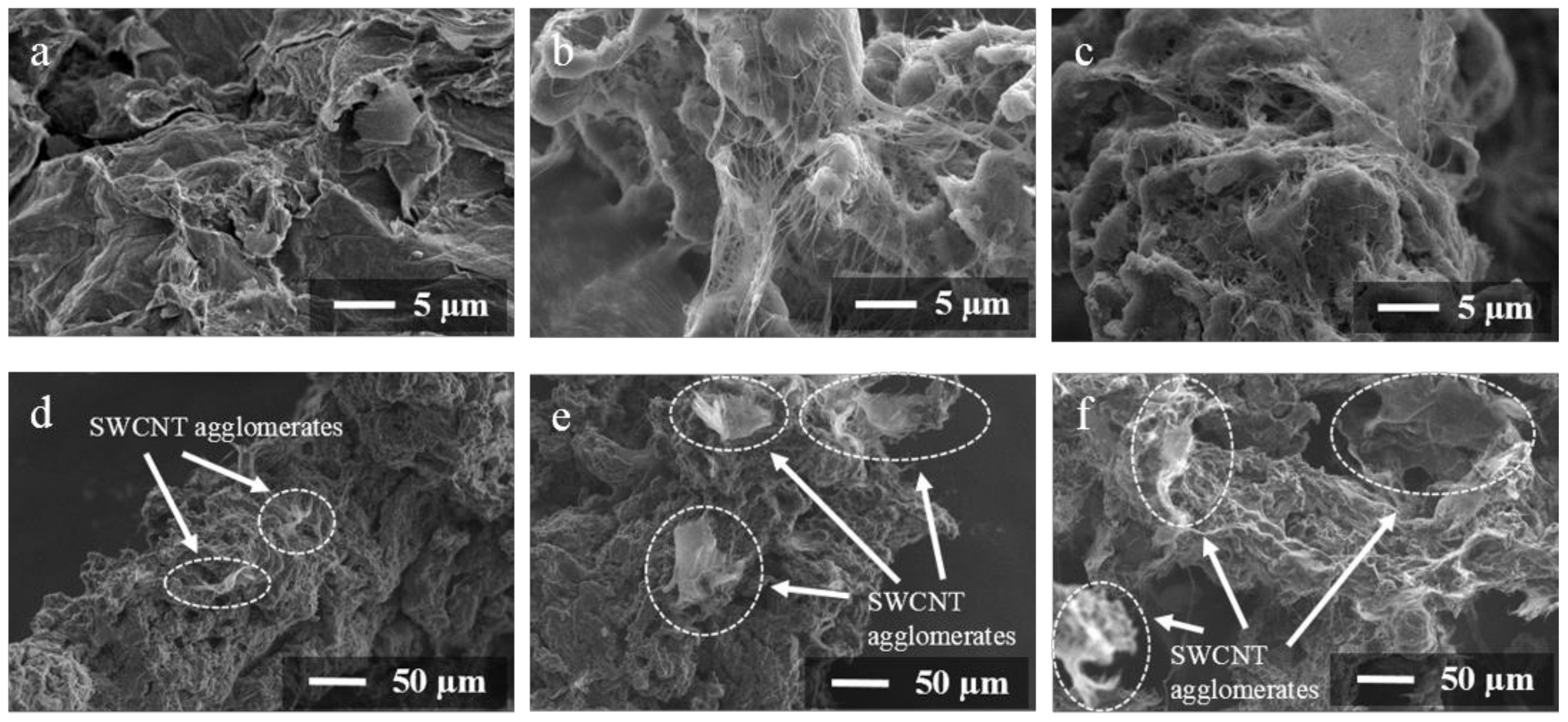
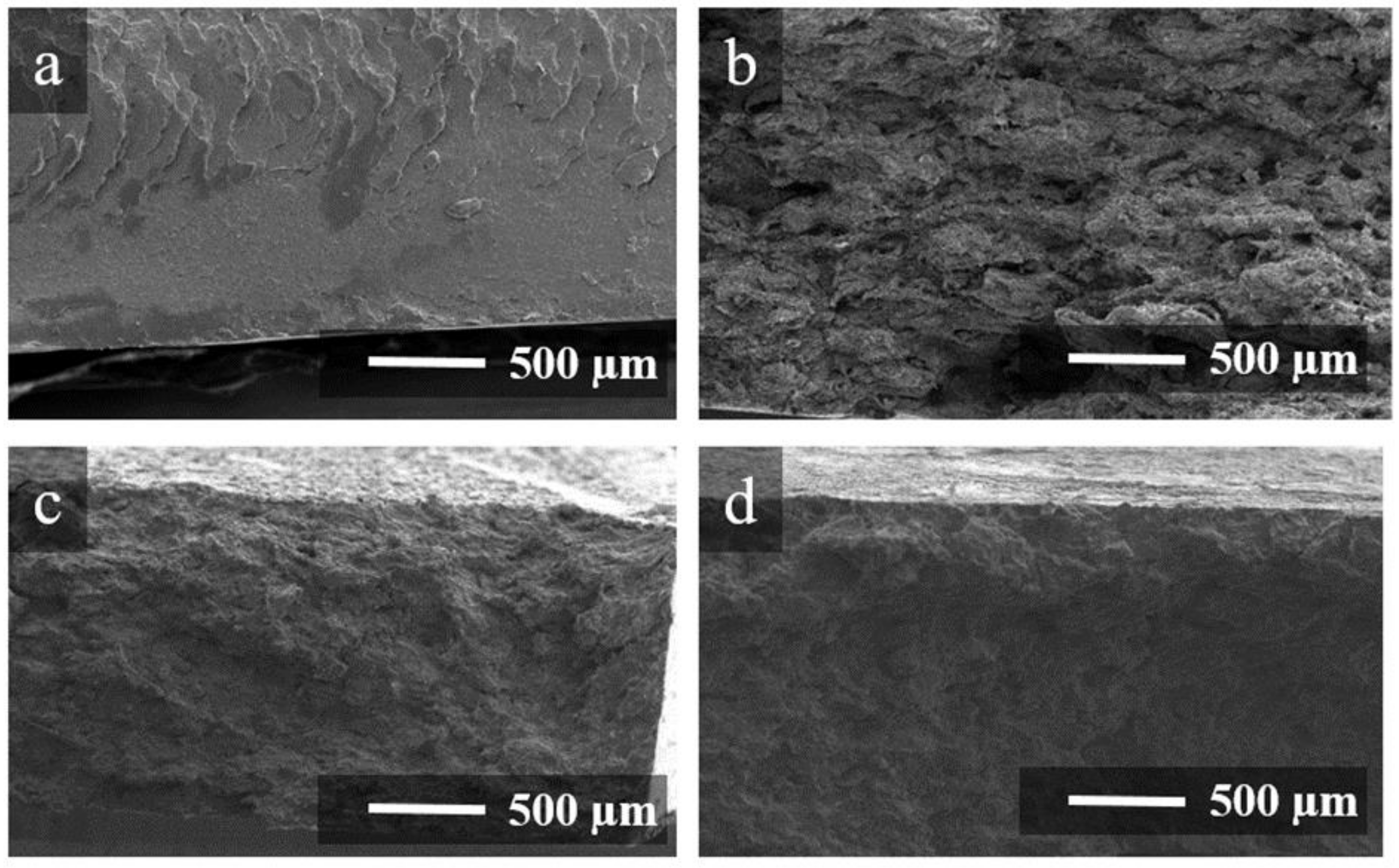
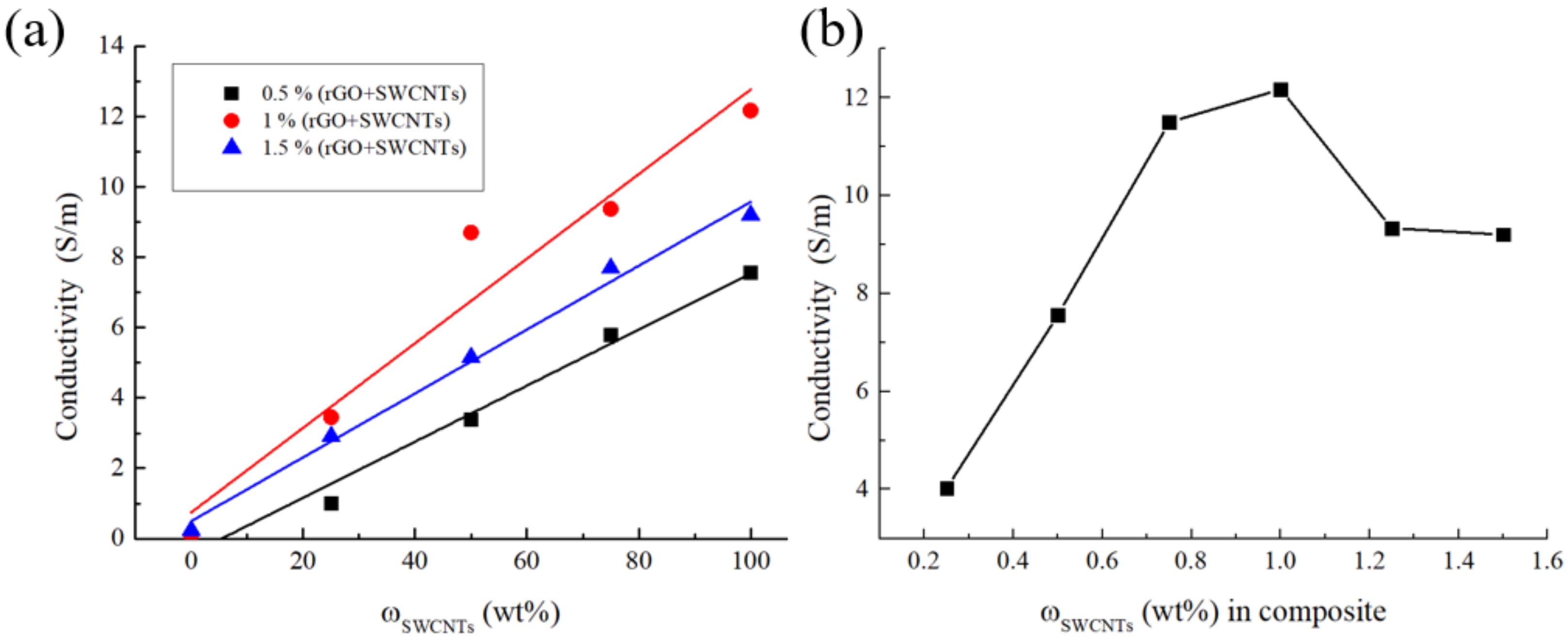
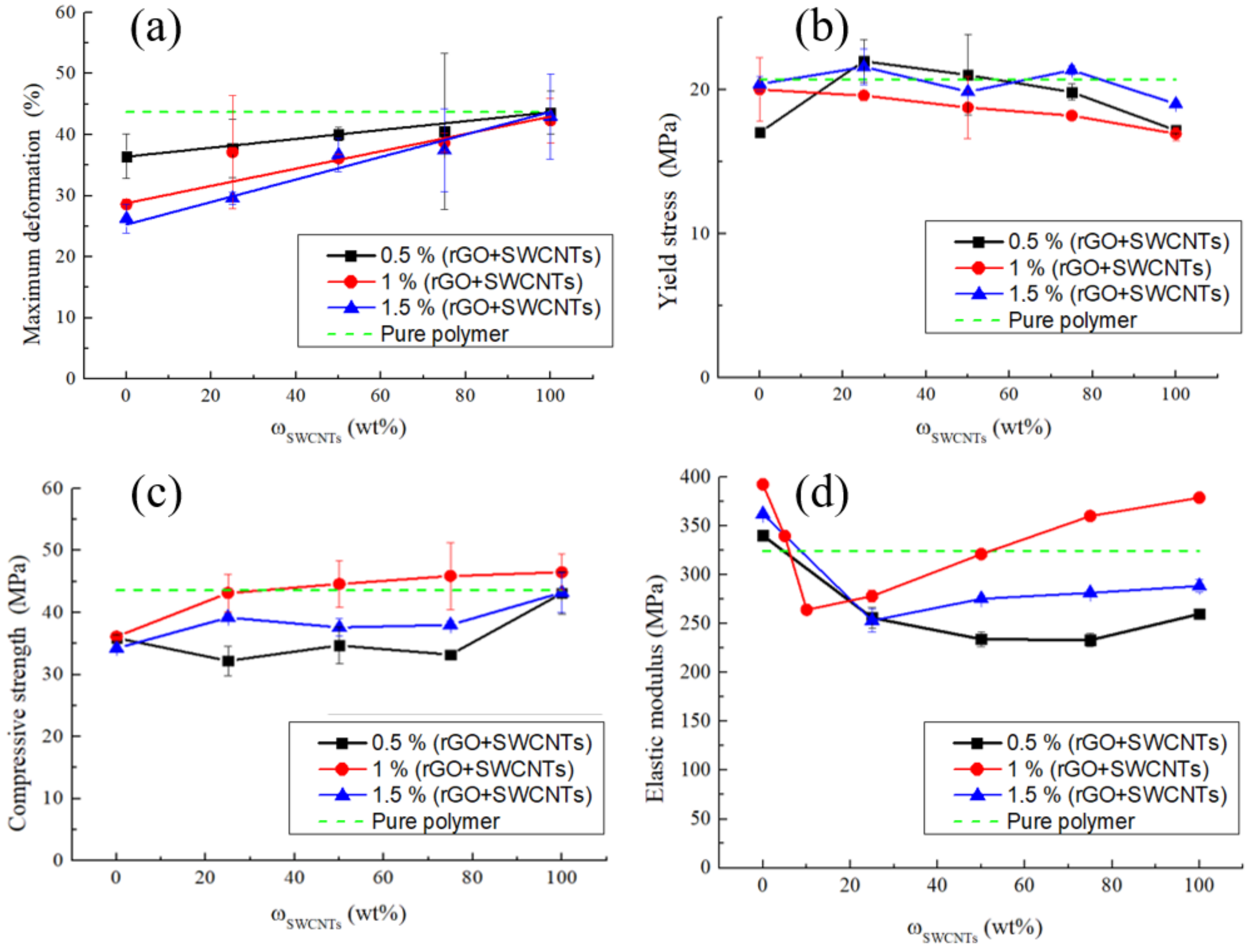
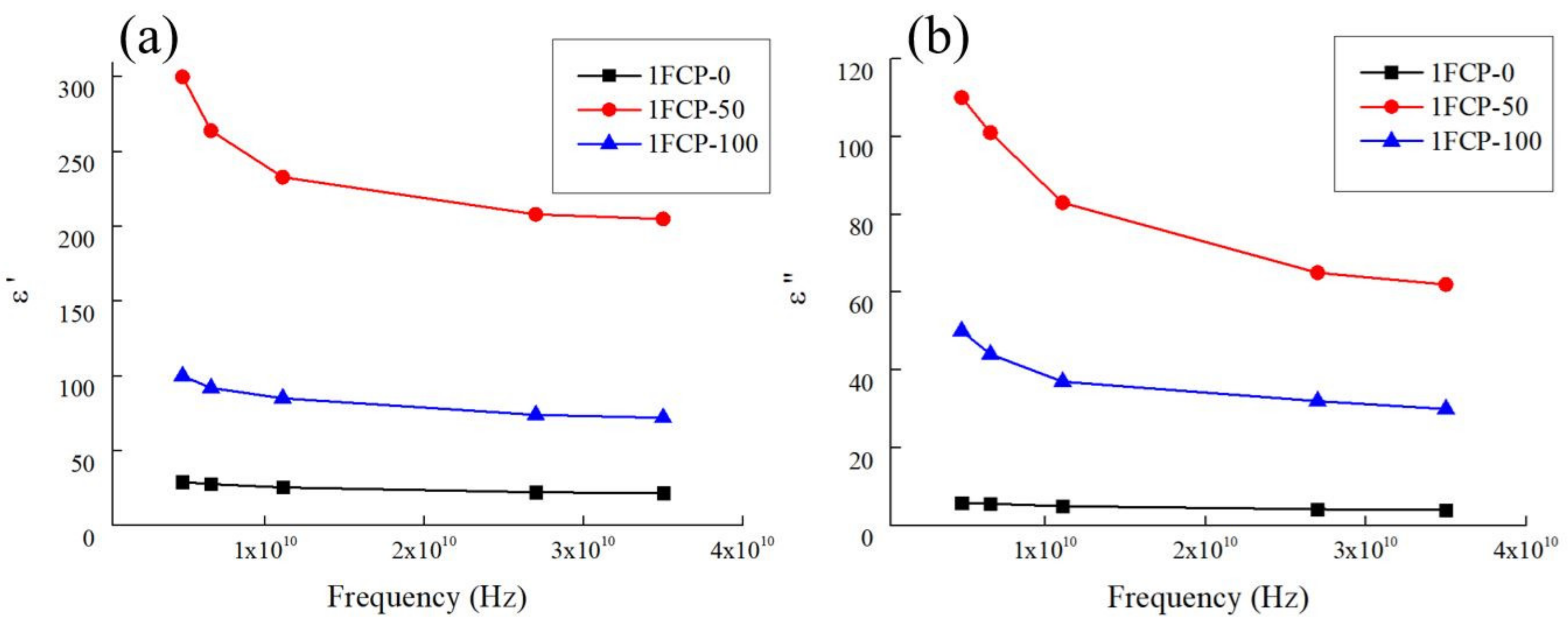
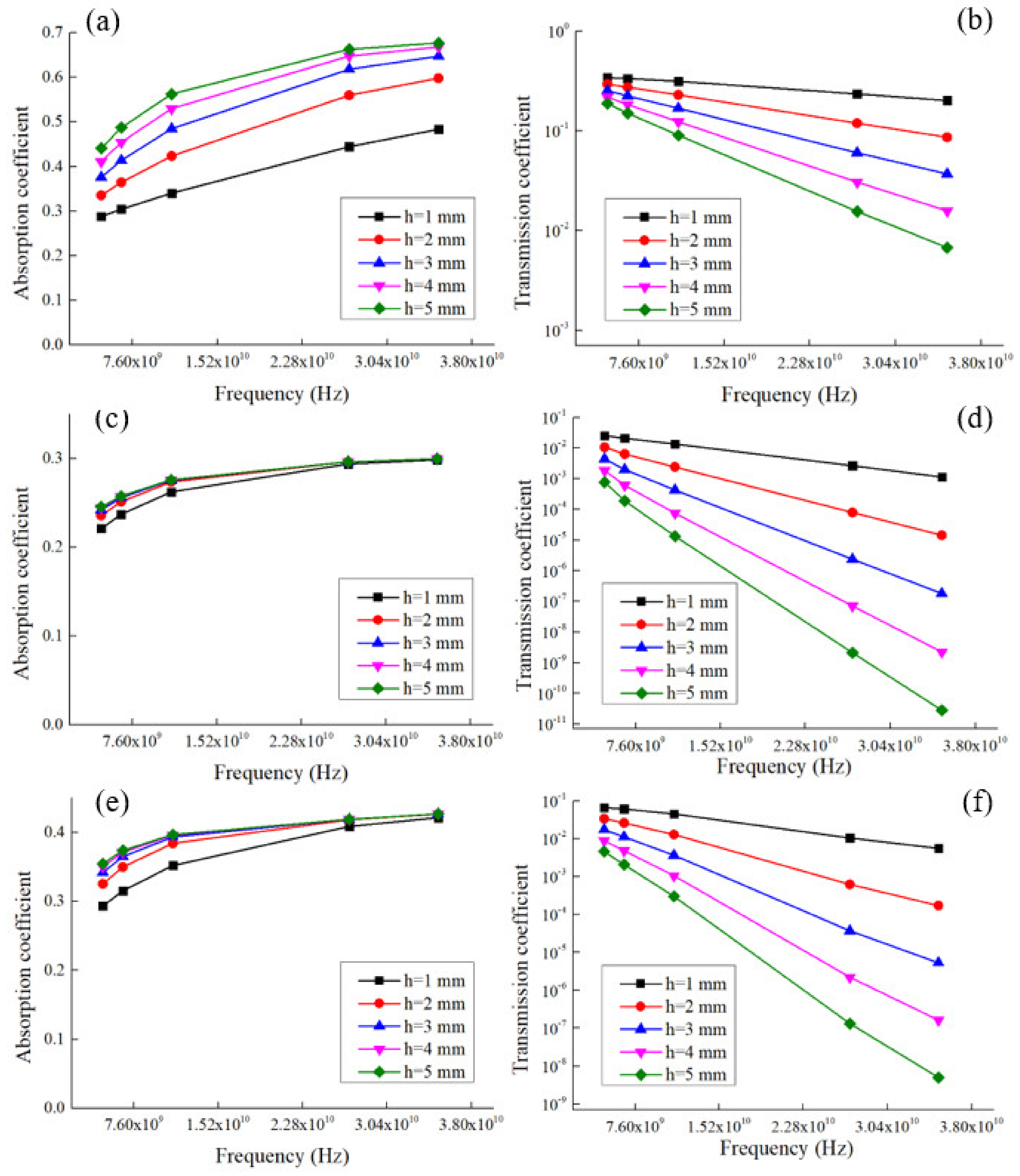
| Sample | ωrGO+SWCNTs, % | ωSWCNTs in a Mixture of Carbon Fillers, wt% | ωrGO in a Mixture of Carbon Fillers, wt% |
|---|---|---|---|
| 0.5FPC-0 | 0.5 | 0 | 100 |
| 0.5FPC-25 | 0.5 | 25 | 75 |
| 0.5FPC-50 | 0.5 | 50 | 50 |
| 0.5FPC-75 | 0.5 | 75 | 25 |
| 0.5FPC-100 | 0.5 | 100 | 0 |
| 1FPC-0 | 1 | 0 | 100 |
| 1FPC-25 | 1 | 25 | 75 |
| 1FPC-50 | 1 | 50 | 50 |
| 1FPC-75 | 1 | 75 | 25 |
| 1FPC-100 | 1 | 100 | 0 |
| 1.5FPC-0 | 1.5 | 0 | 100 |
| 1.5FPC-25 | 1.5 | 25 | 75 |
| 1.5FPC-50 | 1.5 | 50 | 50 |
| 1.5FPC-75 | 1.5 | 75 | 25 |
| 1.5FPC-100 | 1.5 | 100 | 0 |
| Matrix | Filler | Electrical Conductivity, S/m | References |
|---|---|---|---|
| Poly(phenylene ethynylene)/ polycarbonate composite | SWCNTs, 7 wt% | 4.81 × 102 | [17] |
| Polystyrene | SWCNTs, 2 wt% | 10−2 | [18] |
| Polylactic acid | MWCNTs, 2 wt% | 20 | [25] |
| Ultra-high molecular weight polyethylene | MWCNTs, 2 wt% | 2.1 | [26] |
| Epoxy vitrimer | MWCNTs, 4 wt% | 6.8 | [27] |
| Polypropylene | MWCNTs, 1 wt% | 14.2 | [28] |
| Epoxy resin | MWCNTs, 1 wt% | 34.2 | [29] |
| Polyvinylidene fluoride | MWCNTs, 4 wt% | 74.5 | [30] |
| L,d-poly(lactic acid)/ 4-pentyl-4-biphenylcarbonitrile | SWCNTs, 0.05 wt% | 0.024 | [31] |
| P(VDF-TFE) | SWCNTs, 1 wt% | 12.16 | This article |
Publisher’s Note: MDPI stays neutral with regard to jurisdictional claims in published maps and institutional affiliations. |
© 2022 by the authors. Licensee MDPI, Basel, Switzerland. This article is an open access article distributed under the terms and conditions of the Creative Commons Attribution (CC BY) license (https://creativecommons.org/licenses/by/4.0/).
Share and Cite
Shiyanova, K.; Gudkov, M.; Torkunov, M.; Ryvkina, N.; Chmutin, I.; Goncharuk, G.; Gulin, A.; Bazhenov, S.; Melnikov, V. Segregated Structure Copolymer of Vinylidene Fluoride and Tetrafluoroethylene Composites Filled with rGO, SWCNTs and Their Mixtures. Polymers 2022, 14, 4105. https://doi.org/10.3390/polym14194105
Shiyanova K, Gudkov M, Torkunov M, Ryvkina N, Chmutin I, Goncharuk G, Gulin A, Bazhenov S, Melnikov V. Segregated Structure Copolymer of Vinylidene Fluoride and Tetrafluoroethylene Composites Filled with rGO, SWCNTs and Their Mixtures. Polymers. 2022; 14(19):4105. https://doi.org/10.3390/polym14194105
Chicago/Turabian StyleShiyanova, Kseniya, Maksim Gudkov, Mikhail Torkunov, Natalia Ryvkina, Igor Chmutin, Galina Goncharuk, Alexander Gulin, Sergey Bazhenov, and Valery Melnikov. 2022. "Segregated Structure Copolymer of Vinylidene Fluoride and Tetrafluoroethylene Composites Filled with rGO, SWCNTs and Their Mixtures" Polymers 14, no. 19: 4105. https://doi.org/10.3390/polym14194105







